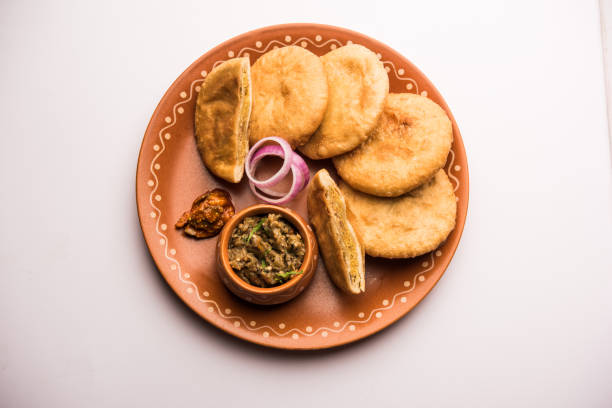When one hears the name Litti Chokha, it immediately brings to mind the smoky aroma of roasted dough balls filled with spicy sattu, paired with a flavorful chokha made from mashed vegetables. While this iconic dish is a staple across Bihar, what many don’t realize is that its taste, preparation, and presentation differ significantly from one region to another within the state.
In this blog, we explore the regional twists and unique versions of Litti Chokha across Bihar’s diverse cultural and geographical landscape — from the plains of Mithila to the tribal regions of Santhal Pargana.
🧭 Why Are There Variations?

Like most traditional Indian dishes, Litti Chokha has evolved locally based on:
- Availability of ingredients
- Climate and terrain
- Cultural preferences
- Influence of neighboring regions
Each area of Bihar has added its own spin, creating versions of Litti Chokha that are distinct yet rooted in the same culinary tradition.
📍 1. Magadh Region (Gaya, Nalanda, Jehanabad)
Signature Style:
- Spicy and robust flavors
- Litti often double-roasted for extra crunch
- Generous use of ajwain (carom seeds) and garlic in the sattu filling
Chokha Twist:
- Tomato chokha dominates here, often mixed with chopped onions, mustard oil, green chilies, and a hint of lemon.
- Some families add a bit of raw mustard seeds for a punchy flavor.
Serving Style:
Traditionally served on sal leaves or banana leaves, and always accompanied by lots of ghee poured over the hot littis.
📍 2. Bhojpuri Region (Ara, Buxar, Siwan, Chhapra)
Signature Style:
- Litti is often larger in size, with extra ghee mixed into the dough itself.
- Some recipes include finely chopped coriander and pickle masala in the sattu filling.
Chokha Twist:
- This region favors baingan (eggplant) chokha — made with roasted eggplant, tomatoes, and garlic.
- Smokiness is essential here. The vegetables are usually roasted directly on open flames.
Unique Addition:
In some Bhojpuri households, a side of achar (pickle) or chutney made from dried mango or tamarind is served alongside for tanginess.
📍 3. Mithila Region (Darbhanga, Madhubani, Samastipur)
Signature Style:
- Mithila’s litti is more delicate, often smaller in size and less oily.
- The sattu filling here is milder, flavored with fennel seeds (saunf) and a touch of jaggery.
Chokha Twist:
- Unlike other regions, Mithilanchal sometimes prepares raw chokha – where ingredients like boiled potatoes, mustard oil, green chili, and onions are mixed without roasting.
- Lemon juice and mustard oil are used liberally.
Cultural Note:
This version reflects Ayurvedic principles and seasonal eating habits, especially during summer.
📍 4. Anga Region (Bhagalpur, Banka, Munger)
Signature Style:
- Litti is roasted over charcoal or cow dung cakes, infusing an intense smokiness.
- Sattu is mixed with raw onions, mustard oil, ginger, and pickling spices.
Chokha Twist:
- A mix of boiled potatoes and roasted brinjal is most common.
- Locals may add raw mango (kacha aam) during summer for a tangy touch.
Regional Influence:
The proximity to Jharkhand and Bengal reflects in the spice profile, with some dishes including panch phoron or mustard paste.
📍 5. Seemanchal Region (Purnia, Katihar, Kishanganj)
Signature Style:
- Influenced by Bengali and Muslim cuisines, this version often uses onion seeds (kalonji) and black pepper in the sattu mix.
- Some littis here are lightly fried after roasting for a crispy texture.
Chokha Twist:
- The chokha here is sometimes made only with boiled potatoes and green chili, kept very simple.
- Fresh coriander and mint are often added for freshness.
📍 6. Tribal and Border Areas (Kaimur, Rohtas, Santhal belt)
Signature Style:
- Here, litti is often cooked in clay ovens or over wood fires, using ancient tribal techniques.
- Fillings may include seasonal herbs, wild greens, or even urad dal powder instead of sattu.
Chokha Twist:
- Seasonal ingredients like yam, sweet potato, or raw papaya are used.
- Some chokha versions are fermented or sun-dried before mixing, adding complexity to flavor.
Unique Fact:
In some tribal communities, litti is dipped in homemade mahua oil instead of ghee!
🧂 Common Across All Regions:
Despite the regional differences, a few things stay consistent:
- Use of mustard oil in chokha
- Dependence on local, seasonal vegetables
- Serving with ghee or a spicy chutney
- Traditional preparation over open fire or cow dung cakes, which adds a distinct smokiness
🍛 Modern Regional Fusion
In recent times, Bihari home chefs and restaurants have started blending these regional variations to create fusion platters, offering:
- Mixed chokha thalis – serving eggplant, potato, and tomato chokha separately
- Stuffed littis with dry fruits or paneer (influenced by Mithila sweets)
- Mini-littis inspired by Magadh and Mithila, perfect for snacks
📜 Cultural Significance of Variations
The diversity in preparation is not just culinary but cultural. Each version of Litti Chokha represents:
- The climate and crops of the area
- Caste and community traditions
- Festive practices – some versions are only made during Chhath Puja or marriages
- A reflection of how a single dish adapts to hundreds of family kitchens and tastes
📝 Conclusion: One Dish, Many Stories
Litti Chokha is a culinary canvas, with each region of Bihar painting its own story on it. What unites them all is a shared love for local food, community, and identity.
Whether it’s the fiery Bhojpuri version or the subtle Mithila style, Litti Chokha proves that even a humble dish can carry immense depth, pride, and diversity.
So, next time you eat Litti Chokha, remember — you’re not just tasting one recipe; you’re tasting centuries of culture and countless regional stories on a single plate.